Almost certainly the second most badass interceptor missile ever built, the SPRINT missile was one of the most bland looking. A cone 27 feet long and 4.4 feet in diameter, the SPRINT was nearly featureless except for four small control fins about halfway up. But what it lacked in aesthetics it more than made up for in performance:
1: Acceleration exceeded 100 G’s. This would turn a hypothetical passenger into paste.
2: Maximum speed was in excess of Mach 10, reached in about 5 seconds
3: As a result of the high speed at low altitude, drag and aerothermal heating were immense. The ablative nosecone got hotter than the core burning region of the rocket motors.
4: The warhead was a nuclear bomb. More specifically, an “enhanced radiation” (i.e. “neutron”) bomb of low kiloton yield.
The SPRINT missile was the second in a three-tier anti-missile system known as “Safeguard.” The first tier was the Spartan missile… itself impressive, in that it packed a two megaton nuke and was able to reach incoming targets up to 450 miles away, and 350 miles in altitude (it could be used to take out satellites). Spartan would be used to try to take out incoming missiles while still at some distance. But SPRINT would be used for those warheads that made it past Spartan… intercept altitudes from between 1500 and 30,000 meters. At these altitudes, the detonation of the SPRINTs own warhead would cause damage to soft targets on the ground; thus SPRINT was to be used to defend hardened targets such as ICBM silos.
The neutron bomb warhead would destroy incoming warheads not with blast, but with neutron flux. This would not only damage electronics, causign the warheads to either prematurely detonate, or not detonate at all… the neutron flux would do the fissile materials of the warheads themselves no good, causing the warheads to melt down or burst (though not detonate).
In order to get the high accelerations required for SPRINT, early research on the solid rockets led to some interesting concepts. A former co-worker of mine was involved in the early development in the early 1960’s. One of the more interesting motors tested used propellant that was not so much cast as it was *built.* Normal “composite” solid rockets use propellants such as ammonium perchlorate (an oxidiser that’s a powder something like fine salt, and something like fine flour), aluminum powder (the fuel) and a liquid rubber binder. Mix these all up in something like a giant cake mixer, throw in a catalyst that will cause the rubber to solidify, and pour into the rocket motor. Composite propellants are simple, cheap, reliable and fairly safe, but the burn rate – and thus maximum thrust – can be somewhat limited. “Double base” propellants are generally sportier. Nitrocellulose (AKA “guncotton” to all you Baltimore Gun Club fans) is mixed with nitroglycerine (yes, THAT nitroglycerine), which dissolves the nitrocellulose, and forms a gel; other chemicals cause the mixture to set up as a solid. Adding metals such as aluminum to the mix can increase performance. Double base propellants perform well and can have good, high burn rates. They can also decide to detonate just to be spiteful.
The early SPRINT motor that was described to me was a nitrocellulose/nitroglycerine motor with a difference. Rather than mixing the components and then pouring into the motor, the nitrocellulose powder was sifted into the motor a thin layer at a time. (The motor, conical in shape, was upside down, forming a “cup,” with a metal mandrel in the core. The powder would thus form a layer that would bond to the conical motor walls, and when the mandrel was withdrawn, leave a large void volume in the center.) Then an early industrial robot would reach down into the motor case and carefully place zirconium “staples” onto the powder. These staples were described as looking like regular office staples, except one of the “arms” was bent up 90 degrees so that the staple covered all three X-Y-Z axes. Once the staples were in place, more powder would be added, then more staples, then more powders, etc. When the motor was properly filled with powder and staples, nitroglycerine would be carefully poured in; it would infiltrate the powder and turn it all to gel while leaving the staples in place. The gel would set up solid and the mandrel would be removed from the motor.
The end result was that the zirconium staples would not only burn as fuel, adding performance, being metal they would conduct heat into the propellant. The result of that was that burn rate would be greatly increased, and thus thrust. Apparently it worked great… when it worked. Sometimes it went kerflooey. One motor registered 50,000 psi internal pressure just before it turned into a fiberglass-confetti fireball. Additionally, propellant casting was slow and expensive.
In the end, simpler propellants were used (though the details remain fuzzy). Ammonium perchlorate was added to the propellant powder (presumably nitrocellulose plus other additives), and a solvent was them poured in to cause the mix to set up and bond to the walls. Only a small amount of aluminum powder was added… too much metal in the propellant caused the smoke trail to ionize and disrupt communications with the ground-based controls.
The SPRINT missiles were kept and launched from silos. Due to the need to get the hell out of Dodge in a hurry, normal silo systems were not used. Instead, the cover door over the silo was blow off with explosives; an explosive-actuated piston was used to punch the missile out. Within 1.2 seconds the first stage would burn out; the second stage shortly thereafter.
SPRINT, and the Safeguard system, were operational for only a few short months in late 1975/early 1976, defending the Minuteman missile silos at Grand Forks Air Force Base in North Dakota.
There was a third planned, but not-operational, tier in the defense system: the HiBEX missile. Now *that* was a badass rocket…
An early SPRINT test missile.
———
SPRINT missiles immediately after launch
———–
SPRINT compared with the LoAD (Low Altitude Defense), a later design to protect MX missiles… similar to HiBEX
———-
SPRINT missile, cutaway view
————-
SPRINT launch station
—–
SPRINT videos:
http://www.youtube.com/watch?v=YZZV464z9g8
http://www.youtube.com/watch?v=LsnkmpJhzlo This one features a slo-mo of the launch. Notice that the first stage gets torn to flinders immediately after separation. Also behold as the second stage goes so fast that the whole outer shell begins to glow incandescently.
17 Responses to “SPRINT”
Sorry, the comment form is closed at this time.
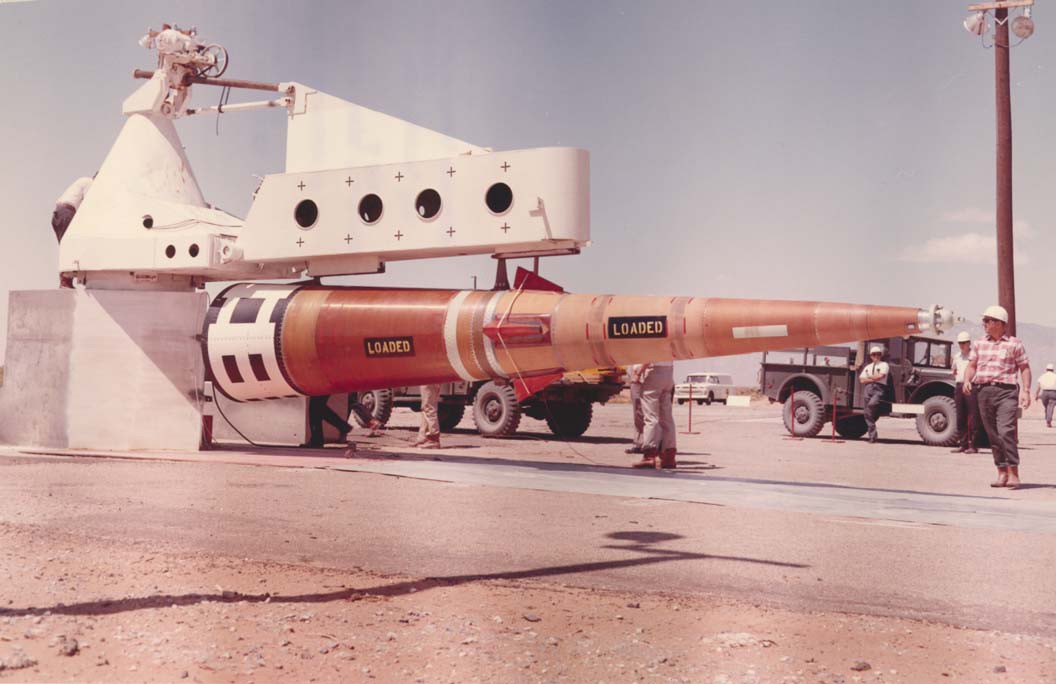
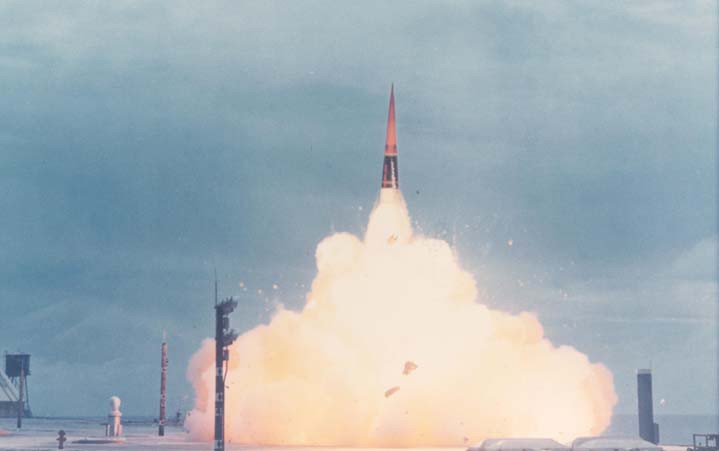
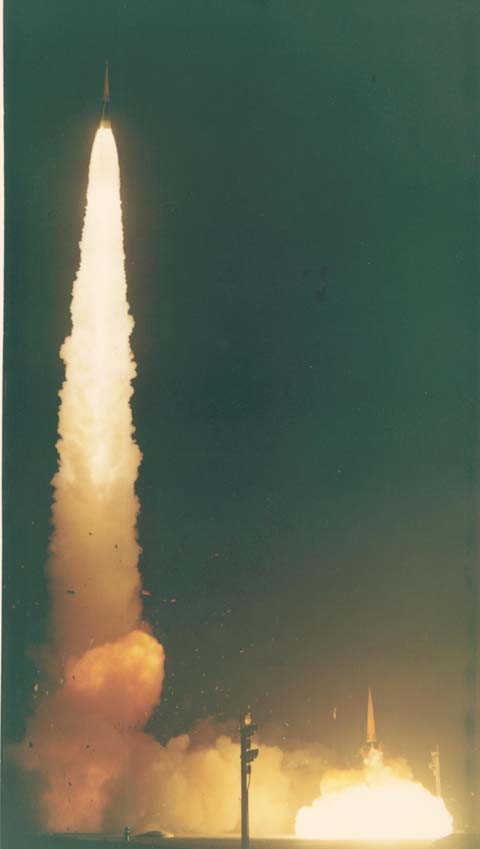
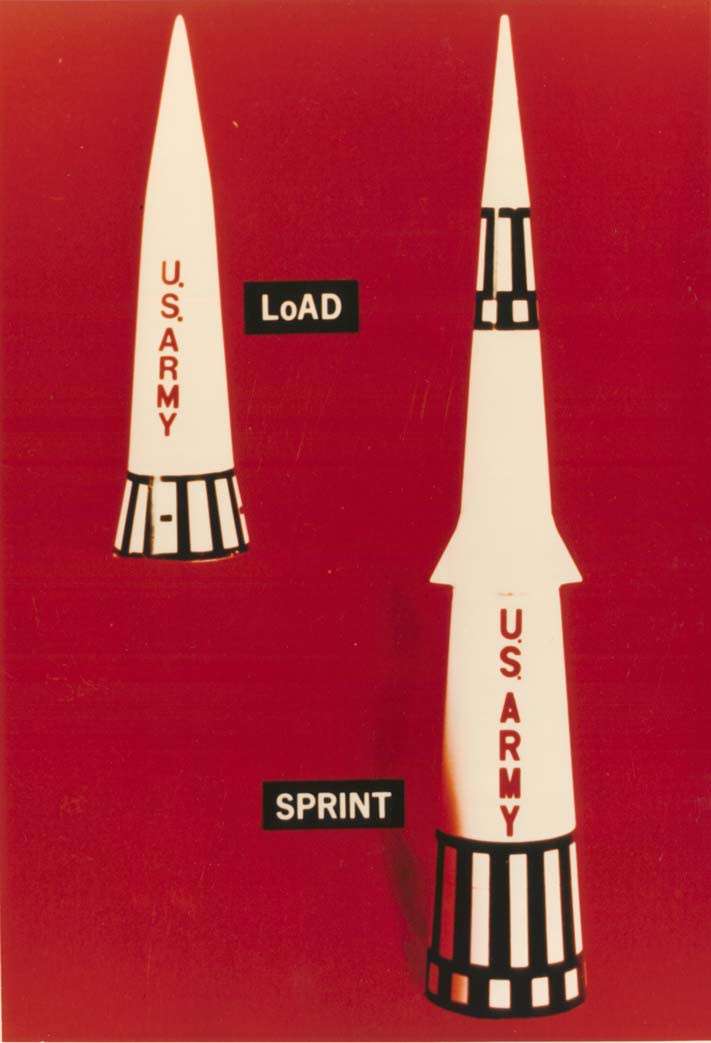
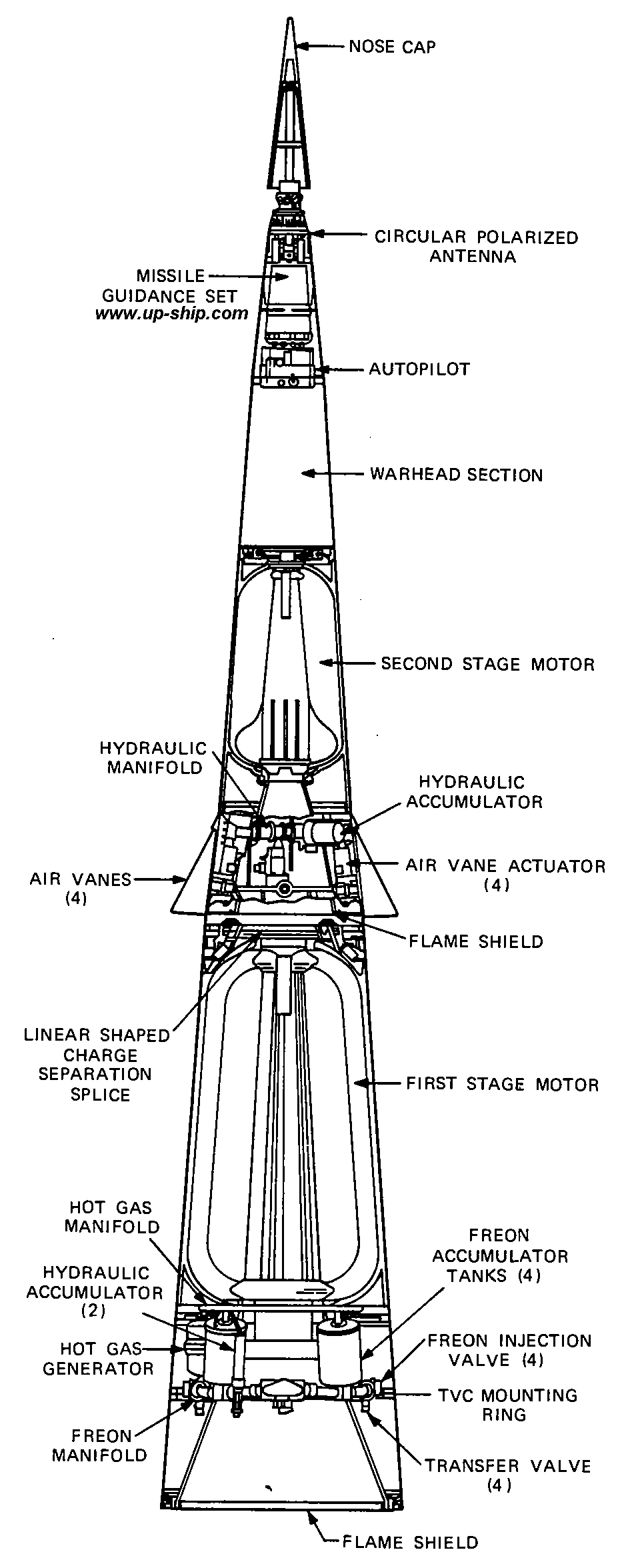
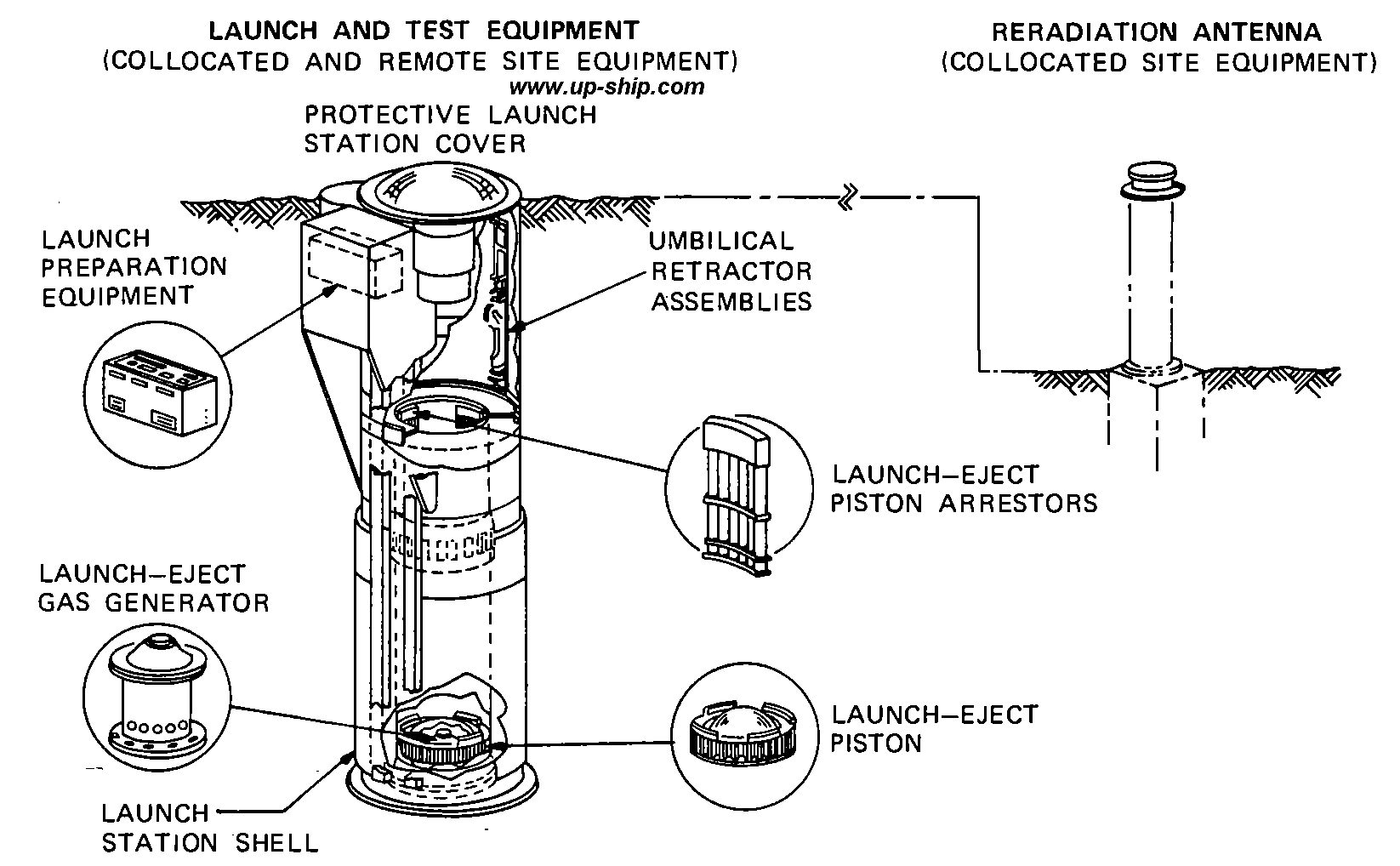
Holy crap that is impressive.
Remarkable.
What was the first most badass interceptor?
Why is stuff like this scrapped?
I believe he meant HiBex was #1. Also, don’t forget HEDI (I think it actually used modified Sprint hardware.) Also, anybody got any info on Sprint II? It was suppose to be an upgraded Sprint but I’ve seen very little on it. Not much more than it was in the works.
As for how hot it got go here:
http://www.youtube.com/watch?v=LsnkmpJhzlo
and watch what happens to it at 0:16.
” Why is stuff like this scrapped? ”
Stupidity or betrayal, take your pick.
*********************
My great uncle built these at the Radford arsenal.
He had described the 1st stage interior as looking like a beehive. He mentioned the zirconium staples but not the later formulation you mentioned….I guess he was only working on the prototypes.
Whoops, looks like I missied the tail end of the original article.
Gee whiz.
Jim
Sprint is where the laser ring gyro came from; they couldn’t develop a normal one that could handle the launch acceleration.
MRVs and later MIRVs made ABMs impractical, as you needed at least one ABM for every incoming warhead (you’d want 2-3 to be on the safe side)
Since every Spartan was going to cost around as much as a Minuteman, that means one Minuteman III would take 3-9 times its own cost to defend against.
In short, you could bankrupt your opponent in no time flat by deploying a lot of multiple warheaded ICBMs or SLBMs and forcing him to try to defend against them.
One Poseidon SLBM for instance could carry up to 14 warheads, so you were talking about just a few swamping the whole Moscow ABM system with its 64 ABM launchers.
Like the 1922 Washington Battleship Treaty, the ABM treaty limited a weapons system that was already becoming obsolete.
Except Spartan took down not RVs, but the bus before the RVs were released. That’s why it had such long range. Sprint was for leakers. Spartan did most of the work.
Be very careful of any negative analysis you read out of the Johnson/MacNamara administration, it was hopelessly biased. The data I’ve seen is that the Minuteman/Spartan cost comparo was not at all apples to apples.
> Like the 1922 Washington Battleship Treaty, the ABM treaty limited a weapons system that was already becoming obsolete.
Massively factually inaccurate. ABMs are nowhere near obsolete, and the US Navy is operating quite a large number of ’em.
And so what if the missiles are expensive? They are far cheaper than the cities, air bases and populations they would defend.
I always did wonder how they made those Sprint missiles accelerate so damn fast.
Admin wrote:
“Massively factually inaccurate. ABMs are nowhere near obsolete, and the US Navy is operating quite a large number of ‘em.
And so what if the missiles are expensive? They are far cheaper than the cities, air bases and populations they would defend.”
Against a limited threat, like NK, Iran, or even China (at the current time) a ABM system can work – as the total number of interceptors needed isn’t that large. But against Russia it has real problems. As of July of this year Russia had a total of 1,248 land based missile warheads and 591 submarine based ones. So unless you can hit their carrier missiles before they release their MIRVs, the numbers game gets pretty severe as you can’t be sure one ABM equals one warhead kill and even a small amount of leakage will still result in your country getting blasted.
Regarding the old Safeguard system, the detonation of the Sprint warheads wasn’t all that bad except for the radiation released as they intercepted warheads in the atmosphere, and shockwave damage if they detonated at fairly low altitude. The high yield warheads and high detonation altitude of the Spartans though meant that every detonation was going to do severe EMP damage to the civilian infrastructure under it to a wide radius.
And the same technology that was being examined to defeat ABMs in the 1970s will still work today; a maneuvering warhead can cause a ABM to fail to intercept by requiring it change its trajectory during the terminal phase of flight to the point where it gets beyond its performance envelope.
This particularly applies in the case of a ABM where an actual impact by a kinetic kill vehicle is required, like our current land and sea based systems.
So of course Russia is developing such a MARV warhead and doing tests on it.
Although that technology is beyond either Iran or NK, it is probably something China can also do.
I particularly liked Bush selling or new ABM system as a counter to the Iranian and NK ICBM threat…after stating that we were not going to let either country develop ICBMs.
I’m sure that sent the right message to both regimes. 🙂
That’s why you use things like MKV and KEI. The One, in His infinite wisdom cancelled both of those. Gotta “reset” the relationship with Putin ya know. And the result?
http://www.google.com/hostednews/afp/article/ALeqM5g5-UC-mRDvnCgaPbrZNlLIAmUFDQ
A few choice bits,
“”To preserve the balance, we must develop offensive weapons systems, not missile defence systems as the United States is doing,” Putin said during a visit to the Russian Pacific port city of Vladivostok.”
“Putin said Washington should share its missile defence plans with Moscow if it wanted to ease Russian alarm on the issue.
“Let the Americans hand over all their information on missile defence and we are ready to hand over all the information on offensive weapons systems,” he said.”
No doubt the Grand Appeaser will jump all over that like a crack whore on a welfare check.
> As of July of this year Russia had a total of 1,248 land based missile warheads and 591 submarine based ones. So unless you can hit their carrier missiles before they release their MIRVs, the numbers game gets pretty severe as you can’t be sure one ABM equals one warhead kill and even a small amount of leakage will still result in your country getting blasted.
So build ten thousand interceptors. We used to be a nation that could manufacture in bulk, and there’s not a damned thing in the world that says that such interceptors cannot be put into series production and for dirt cheap. It’s low rate production and nuclear friggen’ warheads that make ICBMs expensive.
The US can far better afford to build a bagrillion interceptors than our enemies can afford to build the systems to defeat them.
Scott wrote:
>So build ten thousand interceptors. We used to be a nation that could
>manufacture in bulk, and there’s not a damned thing in the world that
>says that such interceptors cannot be put into series production and
>for dirt cheap. It’s low rate production and nuclear friggen’ warheads
>that make ICBMs expensive.
This is of course the way we “won” the Cold War by causing the Soviets to continually spend excessive amounts of money countering our “next” super-weapon or defense system. We can’t and never could have afforded an actual “missile-defense” system large enough and powerful enough to stop enough incoming warheads to matter in a “real” nuclear war. SDI was the closest, most realistic system proposed and it woud have required technology and monetary commitments that the government balked at when our economy was flush, let alone the situation we find outselves in now.
And despite President Reagan’s belief that we COULD build such a system it seems that no one in the DoD or government OTHER than him actually was serious about the concept. While our economy could handle the amounts we were throwing into various programs connected with SDI the Soviet economy couldn’t afford the hits it took to counter those programs and so collapsed. Note that we dropped missile defense as soon as possible after that.
As for the Navy operating “a large number” of ABMs this is facually inaccurate: They operate ONE “ABM” system the rest being AMM (Anti-Missile-Missile)or AAIM (Anti-Aircraft Interceptor Missle) interceptors the ABM version being a modified version of the longerst range most powerful of the type. And because of the cost, space, and other equipment needed to carry, launch, and control those DEFENSIVE missiles most Navy surface “combantant” ships no longer have any actual offensive systems to speak of. They are purely there to keep a carrier safe.
So: Take the cost of a new-model Frigate, mutiply it by the number per carrier group, then multiply that number for each “city, airbase, and population” you want to defend.
(Recall though you ALSO have to worry about the MOST likely way someone will deliver a nuclear device to your defended target: A shipping container, delivery truck or small aircraft)
Now does all this mean I’m against missile defense? Hell-no! I never liked the idea that our ONLY defense was the “fact” everyone knew we’d turn anyone who attacked us first into a large, glowing, parking lot because there is ALWAYS someone who either doesn’t CARE what the “aftermath” of their attack will be, isn’t a “nation” we can readily strike back against, or is just plain crazy enough to think they CAN get away with such an attack. We NEED something in place to address those situations, the falicy though is that we can build a system capable of handling a REAL war, or that “missile” defense will protect us from ‘rogue’ attacks since the MAJORITY of such attacks will by-pass our defenses for the very reasons that they WON’T be using “nation-state” assets such as ICBMs, Armies, Naval or Air Forces.
I HIGHLY RECOMMEND anyone and everyone read a short story called “The First Cup of Coffee War” (included in this collection: http://www.amazon.com/Future-Weapons-War-Baen-Book/dp/1416521127 ) which details a realistic near future attack which a layered “missile” defense system could handle. The question remains open though IF such an attack would occur since the cheaper and more ‘sure’ route would be to insert something more conventional by more “conventional” means.
(Google/YouTube search “SR-71 RC model” or “B-52 RC model” and ask yourself how you’d ‘defend’ against someone flying one of those filled with explosives or chemicals into a target. Lest we forget though I’ll also note that there have been commercially available “GPS-guidance” packages available for years for RC scale models allowing totally autonomous operations…. Now think about THAT for a bit…)
Randy
> We can’t and never could have afforded an actual “missile-defense” system large enough and powerful enough to stop enough incoming warheads to matter in a “real” nuclear war.
Really? Let’s say there are 1500 warheads coming at us. With decoys and malfunctions and such, let’s say it takes a whoppign 10 interceptors per warhead to be reasonably certain of safety. That means 15,000 interceptors. Now lets say that since you’ve put them into serial production, you can procure them for $15 million dollars each. That works out to $225 billion dollars. Which is, what, about one-third of mObama’s first hundred days in office?
> Take the cost of a new-model Frigate, mutiply it by the number per carrier group, then multiply that number for each “city, airbase, and population” you want to defend.
Obviously you would not need the whole frigate, just the relvant fixed bits and pieces. And since you’re not buildign them in the tiny numbers that frigates are, the price per unit drops a *lot.* Now, how does that price per frigate stack up against the price-per-city that you would otherwise leave undefended?
> (Recall though you ALSO have to worry about the MOST likely way someone will deliver a nuclear device to your defended target: A shipping container, delivery truck or small aircraft)
Note that that’s true for *a* target. Terrorists could certainly wipe out a city, maybe several cities, with a boat/truck/plane delivered nuke. That’d be quite horrifically bad. But that’s small change compared to losing *thousands* of cities.
> Google/YouTube search “SR-71 RC model” or “B-52 RC model” and ask yourself how you’d ‘defend’ against someone flying one of those filled with explosives or chemicals into a target.
Easily.

[…] What with the Israeli “Iron Dome” anti-missile system swatting Gazan rockets out of the sky recently, it seems like as good a time as any to post these really quite awful-quality yet still interesting in-flight photos of the Sprint ABM. […]